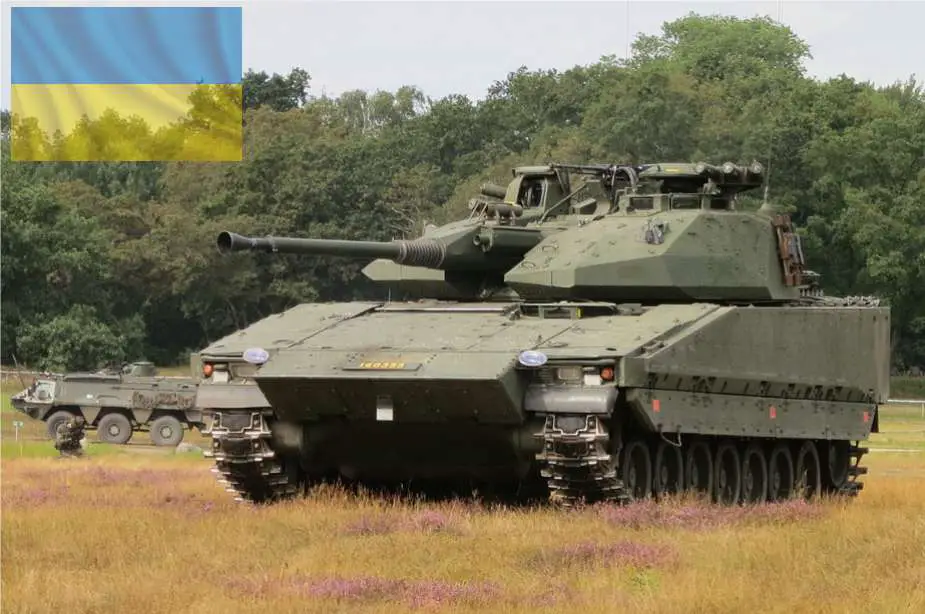- Army
- Conflicts in the world
- Israel - Iran conflict 2025
- Pakistan - India Conflict 2025
- Russia Ukraine War 2022
- Libya conflict day by day
- HAMAS - Israel War 2023
- Operation Serval in Mali French Army
- Sangaris operation Central African Republic
- Sangaris opération militaire République Centreafrique
- Ukraine - Russia conflict
- Syria conflict news
- Defence & Security Industry Technology
- Armies in the world
- Analysis Defense and Security Industry
- Conflicts in the world
- Navy
- Air
Sweden supports Ukraine's ambition for domestic CV90 IFV production
On August 19, 2023, Ukraine and Sweden signed a declaration of intent for the production, repair, and training related to the Swedish-made Combat Vehicle 90 (CV90) infantry fighting vehicles (IFVs). The declaration was made public by Ukrainian President Volodymyr Zelensky in a press conference after his meeting with Swedish Prime Minister Ulf Kristersson.
Follow Army Recognition on Google News at this link

Sweden supports Ukraine's ambition for domestic CV90 IFV production (Picture source Wikimedia)
The primary objective of this collaboration is to localize the joint production and repair facilities of the CV90 vehicles within Ukraine, marking a step towards mutual cooperation in defense and security, while reducing Ukraine's dependence on foreign deliveries.
The specific details of the CV90 model intended for production in Ukraine have not been revealed, but it's understood that these vehicles will adhere to the standard specifications of the CV90 platform.
As part of its defense support, Sweden has delivered around 50 CV9040 IFVs equipped with a 40mm autocannon to Ukraine so far. The IFVs have been deployed within the Ukrainian military, as reported by the Army Recognition editorial team on July 11, 2023. Ukraine has also shown interest in acquiring more of these vehicles, with potential plans to procure up to 1,000 CV90s.
The Combat Vehicle 90 (CV90), developed by the Swedish company Alvis Hägglunds, now a part of BAE Systems, is a series of infantry fighting vehicles made from all-welded steel armor. Introduced in the mid-1990s, the CV90's modular design allows for various configurations, including infantry fighting, anti-aircraft, and command functions. Powered by a Swedish-built diesel engine, the CV90 has a maximum road speed of 70 km/h and a range of 320 km. The vehicle also incorporates an NBC filtration system, chemical and radiation detectors, and heat-absorbing filters.
The CV9040, known as Strf 9040 in the Swedish army, is equipped with a Bofors 40mm autocannon. It also features a 7.62mm coaxial machine gun M/39 and two Bofors Lyran 71 mm mortar tubes. The gunner's station is equipped with a SaabTech Vetronics Universal Tank and Anti-Aircraft System (UTAAS) sight, which provides both day and night channels and a laser rangefinder.
When compared to the BMP-1, BMP-2, and BMP-3 IFVs used by the Ukrainian forces, the CV9040's 40mm gun offers a balance between firepower and ammunition capacity, making it versatile against a range of targets, including infantry, light armored vehicles, and low-flying aircraft. In contrast, the BMP-1 features a 73mm smoothbore gun primarily designed for armored targets. While its caliber delivers a significant punch, its range and accuracy are somewhat limited. The BMP-2 is armed with a 30mm automatic cannon, which, with its rapid rate of fire, is effective against infantry, light armored vehicles, and helicopters. The BMP-3 stands out with its combination of a 100mm rifled gun (also capable of firing ATGMs) and a 30mm autocannon, allowing it to engage a diverse set of targets.
In terms of protection, the CV9040 utilizes composite armor, safeguarding it against 30mm APFSDS rounds. The design also facilitates the addition of extra armor, allowing for enhanced defensive capabilities tailored to specific mission requirements. The BMP-1 and BMP-2, with their aluminum armor, primarily offer protection against small arms fire and shell splinters, making them more vulnerable to larger caliber weapons and contemporary anti-tank systems. The BMP-3 presents a significant upgrade in this department, featuring improved armor that provides enhanced resistance against a wider array of threats.
The CV9040 excels in mobility, achieving a top speed of 70 km/h and demonstrating commendable maneuverability across diverse terrains. This allows for rapid repositioning, granting tactical flexibility during confrontations. The BMP series, with its amphibious capabilities, possesses a distinct advantage in scenarios involving water obstacles. This amphibious nature is especially crucial for operations requiring river crossings or maneuvers in wetland areas.
Sweden's support for Ukraine includes the provision of spare parts, emergency supplies, and ammunition. This aid is estimated at 1.1 billion Swedish Krona (around USD 91 million).
Sweden is also involved in training Ukrainian military personnel. President Zelensky mentioned Prime Minister Kristersson's efforts in this area, especially regarding the Archer self-propelled howitzer training. There are ongoing discussions about potentially supplying Gripen jets to Ukraine.
Sweden is considering a new military aid package of $313.5 million for Ukraine. If approved, this would be the 13th package since the conflict's inception, bringing Sweden's total aid to Ukraine to approximately $1.8 billion.


























